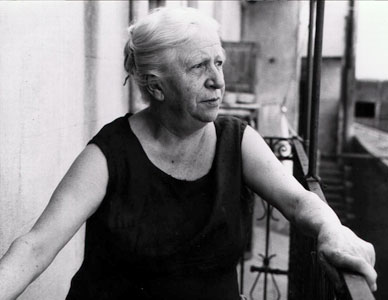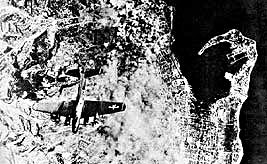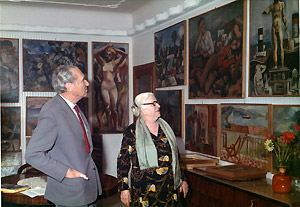|

|
|
Emma Hess in a picture taken in 1967 |
This website is dedicated to the memory of Emma
Hess who, during World War Two, rescued the works of her
brother, Louis-Christian, who in the 1930s had gone into
voluntary exile in Messina, Sicily, where she was living
at the time, to escape persecution from the Nazis. When
the winds of war starting blowing across Italy, the
artist entrusted his works to his sister and left for
Switzerland, to seek a new refuge. Emma had the
perseverance to keep the works for thirty years, firmly
convinced that one day she would have the opportunity to
make them known and appreciated by the public. Thank you
Emma! Visitors to the website should be grateful for the
opportunity offered to them to enjoy the works and
documents that shed light over a dark period in German
art between the wars. The works of an artist who was in
danger of being forgotten, because he died young, at 48,
in the hospital of Schwaz after
an air raid over Innsbruck, can now live again.
|
Air raids over Messina |
 |
|
Summer 1943 –
Two pictures of the Anglo-American daytime and
night air raids over the port and Straits of
Messina, strategic geographical locations
closely controlled during the withdrawal of the
German forces from the island. |
|
|
In those terrible years before the Allied
landing in Sicily, Messina suffered massive bombings,
day and night, by the Anglo-American air force, due to
its strategic position, as a result of which the city
was later awarded the Gold Medal for Civilian Bravery
for the hardships and destruction it suffered. The waves
of bombs were a continuous threat for her brother’s
paintings, so, to protect them, Emma rolled and wrapped
them up, all together, so that they could be easily
carried to the air-raid shelters. On 16 August 1943, the
US Eighth Army entered Messina, during the final attack
to free the island. The war may have come to an end on
the island, but in Central Europe it was still raging.
Emma was worried because she had received no
more news from her brother. Unfortunately, mail could
not enter or leave Italy because the Germans had took
position along the so-called “Gothic Line” and
effectively cut the country in two. An unbearable
silence stretched out day after day for over a year,
until the Red Cross circulated the news of his death, on
26 November 1944. Her brother’s death was a great blow
to Emma, whose greatest hope became that he might
continue to live on through his works, which she never
failed to protect, always looking out for a good
opportunity to share them with the world. So, in 1956,
she exhibited several of his works, without much
success, in Messina, at that time a sleepy and insensitive provincial town. Five years later, at long
last, the great opportunity appeared on the horizon in
the form of a project aimed at rediscovering the work of
Christian Hess, a difficult challenge that nobody had
ventured before. With Emma’s help it was possible to
gather all the available information to undertake
studies and research on the artist’s life, on his known
and lost production, on the activities and exhibitions
held in various German cities in the 1920s and 1930s, on
the reviews of the time, on the witnesses still living
in Munich, the place where he received his artistic
training, Bolzano, his birthplace, and Innsbruck, the
city that hosted his first exhibitions. A thorough, slow, long-term project to gather the
necessary photographic evidence of the principal
elements of his pictorial language. Only one year before
the date set for the event, when everything was running
to schedule: the restoration of his works, the visits by
art critics and journalists, support to the programme of
the itinerant exhibition, the catalog, Emma – who was by
now certain that her dream would finally come true –
passed away peacefully, on 26 September 1973.
|
 |
Messina 1972 - Emma Hess at home with the
German art critic Hans Eckstein, who had
come expressly from Munich to examine the
recently restored works of Louis Christian
Hess.
|
In the meantime, the
project had obtained the sponsorship of the
European Parliament and the support of the
Region of Sicily, the Goethe Institut, the
Tiroler Landes Museum in Innsbruck, the
Künstverein in Munich, the City of Bolzano and
other institutions. From Palermo, where it
opened first, the Rediscovery Exhibition moved
to 12 different locations in Italy, Austria and
Germany – between 26 November 1974 to 6 March
1977 – thus restoring Louis Christian Hess, on
the thirtieth anniversary of his death, to his
rightful place in the history of art. Today, in
the era of the Internet, this cultural
Association named after the Artist, intends to
extend the Rediscovery to a global plane through
this website, which pays tribute to the memory
of Emma and continues her wishes.
We would like to deliver Emma’s message to all
our visitors, inviting you to spread Christian
Hess’ name and art, wherever you may be.
|